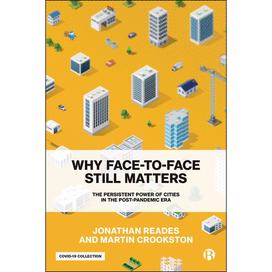Jonathan Reades ’97 on Face-to-Face Communication in Business
The book: Why Face-to-Face Still Matters: The Persistent Power of Cities in the Post-Pandemic Era (Bristol University Press) reveals the importance of city life for promoting face-to-face communication in a digital age. In the wake of a pandemic — and as working from home becomes more prevalent — Reades urges us to consider what is lost in the switch to remote workspaces. Through interviews with business leaders in a range of innovation-rich industries and research into centuries’ worth of wisdom on businesses and cities, Reades learned the continuing value of location even during the information revolution and the rise of artificial intelligence. A book for developers, investors, policymakers, and academics, Why Face-to-Face Still Matters urges readers to consider the value of city life and face-to-face communication in our modern economy — and what that means for the future of business.

Excerpt:
If the 21st century has a dominant metaphor, it is the network. Network ways of thinking now pervade science to an extraordinary extent: it is how brain researchers envision our grey matter, how public health officials think about the spread of Ebola or COVID-19, how ecologists think about ecosystems, how we think about computers and devices, as well as how we think about society itself. Of course, in popular culture ‘networking’ used to mean little more than having after-work drinks but, thanks to the rise of always-on, internet-enabled devices and the social media that they have enabled, we can now — at the click of a button — search our own social networks for long-lost friends (Facebook) or someone able to make a key business introduction (LinkedIn), or stay abreast of breaking news (Twitter).
But there is not just one network for moving ‘stuff’ around, there are many: air, rail, road, sewerage and power, not to mention fixed and mobile ... These overlapping, complementary and competing systems form the substrate upon which economic life grows but, as it grows, the infrastructure responds: strengthening links here, pruning them there. When was the last time it struck you how miraculous it is that you can check local traffic before you get up from the breakfast table, use real-time services to time your departure from the house so that you arrive at the bus stop just before the airport express service arrives, pass through a toll plaza as if you have a magic wand, and then fly anywhere in the world, with your primary concern — pre-coronavirus — being the length of the queue to have your passport checked?
We are adjusting very quickly to devices and services that would have seemed miraculous even 20 years ago. But let’s take a step back from the radical and ongoing changes to what we carry in our pockets and purses. Have a look out the window and chances are that you will be staring at some kind of network for moving physical “stuff” — people or products — around. These other networks are much less “sexy,” and seem to change at a much slower rate than our phones and “phablets,” but they are no less important! Let’s remember too that this digital omnipresence does not mean that the personal touch has been relegated to second place, but if we start with the networks then it will be easier to see what is, and is not, changing in the role of face-to-face contact.
‘This time it’s different’
What makes the telecommunications networks seem different from all of those other networks is that they can carry anything that can been coded digitally: lines from a sonnet, our partner’s voice, our children’s faces, massive data sets, even designs for printing out new parts. This adaptability and instantaneity appears so dramatically different from the more mundane advances of, say, tarmac or the jet engine that, from our privileged position in the early years of the 21st century we tend to think — like thousands of investors and pundits before us — that ‘this time it’s different’.
We spent 60 years waiting for the videophone, from the demo that had visitors talking at the 1964 World’s Fair, only to take it almost completely for granted — to the point of being irritated by choppy video or poor sound quality — when it finally arrived in the form of Skype. And FaceTime. And Teams. And Zoom. And other services now long-gone. To rub salt in AT&T’s wound, now that all these choices are here, they are not just cheap, they’re basically free except when we want to connect to one of those boring old, regulated legacy networks. If you were born as late as the 1980s, did you ever think that, within 25 years, you’d be able to access the internet wirelessly almost anywhere in the world using a powerful computer the size of your hand?
When we look at it this way, where’s the transformation in the networks that move ‘stuff’ around? Where’s that flying car we were promised? Would you settle for a flying bus instead? Perhaps one branded EasyJet or Southwest, JetBlue or Ryanair? We may not have KITT (David Hasselhoff’s AI TransAm), but it’s increasingly obvious that some sort of self-driving car is parked just around the corner. So just because our own cars don’t yet drive themselves or fly us from A to B, it doesn’t mean we shouldn’t recognize that there have been some pretty radical changes in transport recently, both in the networks themselves, and in how they are used.
ICT is, of course, the enabler of these changes, but you’ll note that their primary application has been in making it easier to move stuff around, not to save us from having to move it around at all. We keep thinking that digital telecommunications is somehow different from everything that came before. The seeming ‘placelessness’ of data — everywhere, and nowhere — looks to be a big contrast to the ‘grounded’ way that everything was before. And this, we suspect, is one of the reasons that the “death of distance” is an idea that refuses to die. In the age of “big data,” we tend to forget that the massive growth of the airline network is driven by our persistent preference to “acquire” data the old-fashioned way: in person, and face-to-face. …
We need to look a lot more carefully at what our infrastructure networks actually do and how we can put the physical and informational aspects of all networks into some kind of a relationship to their social and economic functions. We tend to forget that even wireless networks have a physical structure — what experts term a “topology” — that affects where and when they can offer their services. Or, to put it another way: why do you get great 4G reception and free Wi-Fi in New York City, but not those rural areas where you need it a whole lot more?
Review: "A persuasive reminder of why cities will continue to thrive in a digital world — they enable people to share knowledge and experiences, to work together and to innovate through face to face contact." -Andrew Carter, Centre for Cities












No responses yet